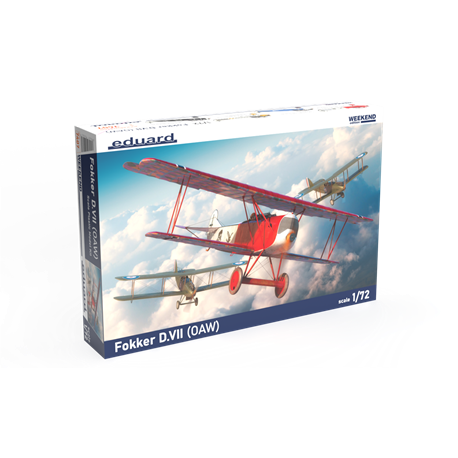No products
Product successfully added to your shopping cart
There are 0 items in your cart. There is 1 item in your cart.
 View larger
View larger Fokker D.VII (OAW) 1:72 scale Weekend edition kit
EDK7407
Eduard
Weekend edition kit of German WWI fighter aircraft Fokker D.VII in 1/72 scale.
This product is out of stock
| Scale | 1:72 scale |
| Material | Plastic |
| Assembly | Kit |
| Finish | Unpainted |
More info
Weekend edition kit of German WWI fighter aircraft Fokker D.VII in 1/72 scale.
The Fokker name is very prominent to the WWI. With his Eindeckers the real aerial combat emerged, while the Dr.I gave the German pilots decent performer. Then the D.VII arrived and defined the term Air Superiority Fighter, as it surpassed all the opponents
Anthony Fokker, the “Flying Dutchman,“ designed some of the most important airplanes of the time and his Fokker D.VII is regarded as the best German fighter of Great War and also one of the best of its time
During the second half of 1917, the Germans were gradually losing their air superiority over the Western front. The Albatros D.III or Fokker Dr.I had been overshadowed by the new Allied arrivals like Sopwith Camel, S.E.5a or SPAD XIII. To get the Deutsche Luftstreitkräfte (German Air Force) back to the shape, the IdFlieg (Inspektion der Fliegertruppen - Inspectorate of the Flying Units) invited manufacturers to the first fighter competition to be held at Adlershof during January 1918. To participate, Fokker ordered his experimental workshop in Schwerin, led by Reinhold Platz, to design and build a biplane prototype in September 1917
Originally, it was to be powered by rotary engine, but thanks to the termination of Albartos D.V production, the Mercedes in-line six cylinder D.IIIa 160 hp (120 kW) engine became available. Platz had taken all the best features of his earlier designs, added some novelties and mixed them into new prototype V 11 (Versuchsmachine no. 11; Experimental aircraft No. 11), which was entered for the competition alongside seven other Fokker prototypes.

